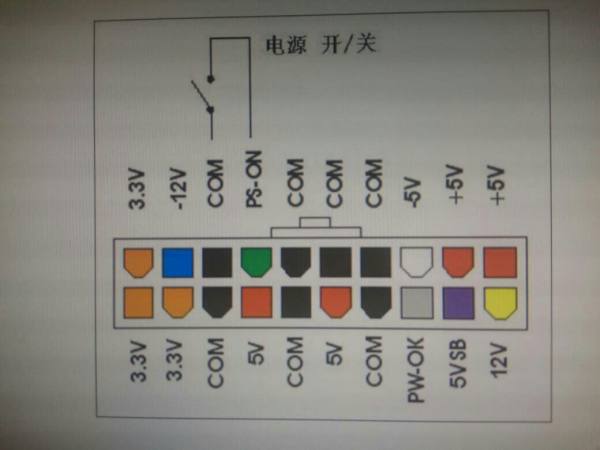请教高手们:电脑ATX电源里的绿线和黑色短接后的电流是多大?
Posted
tags:
篇首语:本文由小常识网(cha138.com)小编为大家整理,主要介绍了请教高手们:电脑ATX电源里的绿线和黑色短接后的电流是多大?相关的知识,希望对你有一定的参考价值。
请教高手们:电脑ATX电源里的绿线和黑色短接后的电流是多大?
电脑ATX电源里的绿线和黑色短接后没有电流。
ATX电源的特性就是,绿线和黑线短接后,电源会启动工作。
即使电源不带有任何负载,短接这两根线以后,电源也会启动工作。当然,此时由于没有负载,当然也不存在电流的问题。
至于这两根线本身,即使短接也没有电流,同样是没有负载。如果有电流,电源岂不是要烧了。

iOS 中的裁剪视频在视频周围看到奇怪的绿线
【中文标题】iOS 中的裁剪视频在视频周围看到奇怪的绿线【英文标题】:Crop video in iOS see weird green line around video 【发布时间】:2015-04-08 03:53:34 【问题描述】:大家好,我正在裁剪从 iPhone 上的相机拍摄的视频,然后将其裁剪并像这样播放。但是,当我这样做时,我会在视频的底部和右侧看到一条奇怪的绿线?不知道为什么会发生这种情况或如何解决它。这是我的裁剪方式。
- (UIImageOrientation)getVideoOrientationFromAsset:(AVAsset *)asset
AVAssetTrack *videoTrack = [[asset tracksWithMediaType:AVMediaTypeVideo] objectAtIndex:0];
CGSize size = [videoTrack naturalSize];
CGAffineTransform txf = [videoTrack preferredTransform];
if (size.width == txf.tx && size.height == txf.ty)
return UIImageOrientationLeft; //return UIInterfaceOrientationLandscapeLeft;
else if (txf.tx == 0 && txf.ty == 0)
return UIImageOrientationRight; //return UIInterfaceOrientationLandscapeRight;
else if (txf.tx == 0 && txf.ty == size.width)
return UIImageOrientationDown; //return UIInterfaceOrientationPortraitUpsideDown;
else
return UIImageOrientationUp; //return UIInterfaceOrientationPortrait;
- (AVAssetExportSession*)applyCropToVideoWithAsset:(AVAsset*)asset AtRect:(CGRect)cropRect OnTimeRange:(CMTimeRange)cropTimeRange ExportToUrl:(NSURL*)outputUrl ExistingExportSession:(AVAssetExportSession*)exporter WithCompletion:(void(^)(BOOL success, NSError* error, NSURL* videoUrl))completion
// NSLog(@"CALLED");
//create an avassetrack with our asset
AVAssetTrack *clipVideoTrack = [[asset tracksWithMediaType:AVMediaTypeVideo] objectAtIndex:0];
//create a video composition and preset some settings
AVMutableVideoComposition* videoComposition = [AVMutableVideoComposition videoComposition];
videoComposition.frameDuration = CMTimeMake(1, 30);
CGFloat cropOffX = cropRect.origin.x;
CGFloat cropOffY = cropRect.origin.y;
CGFloat cropWidth = cropRect.size.width;
CGFloat cropHeight = cropRect.size.height;
// NSLog(@"width: %f - height: %f - x: %f - y: %f", cropWidth, cropHeight, cropOffX, cropOffY);
videoComposition.renderSize = CGSizeMake(cropWidth, cropHeight);
//create a video instruction
AVMutableVideoCompositionInstruction *instruction = [AVMutableVideoCompositionInstruction videoCompositionInstruction];
instruction.timeRange = cropTimeRange;
AVMutableVideoCompositionLayerInstruction* transformer = [AVMutableVideoCompositionLayerInstruction videoCompositionLayerInstructionWithAssetTrack:clipVideoTrack];
UIImageOrientation videoOrientation = [self getVideoOrientationFromAsset:asset];
CGAffineTransform t1 = CGAffineTransformIdentity;
CGAffineTransform t2 = CGAffineTransformIdentity;
switch (videoOrientation)
case UIImageOrientationUp:
t1 = CGAffineTransformMakeTranslation(clipVideoTrack.naturalSize.height - cropOffX, 0 - cropOffY );
t2 = CGAffineTransformRotate(t1, M_PI_2 );
break;
case UIImageOrientationDown:
t1 = CGAffineTransformMakeTranslation(0 - cropOffX, clipVideoTrack.naturalSize.width - cropOffY ); // not fixed width is the real height in upside down
t2 = CGAffineTransformRotate(t1, - M_PI_2 );
break;
case UIImageOrientationRight:
t1 = CGAffineTransformMakeTranslation(0 - cropOffX, 0 - cropOffY );
t2 = CGAffineTransformRotate(t1, 0 );
break;
case UIImageOrientationLeft:
t1 = CGAffineTransformMakeTranslation(clipVideoTrack.naturalSize.width - cropOffX, clipVideoTrack.naturalSize.height - cropOffY );
t2 = CGAffineTransformRotate(t1, M_PI );
break;
default:
NSLog(@"no supported orientation has been found in this video");
break;
CGAffineTransform finalTransform = t2;
[transformer setTransform:finalTransform atTime:kCMTimeZero];
//add the transformer layer instructions, then add to video composition
instruction.layerInstructions = [NSArray arrayWithObject:transformer];
videoComposition.instructions = [NSArray arrayWithObject: instruction];
//Remove any prevouis videos at that path
[[NSFileManager defaultManager] removeItemAtURL:outputUrl error:nil];
if (!exporter)
exporter = [[AVAssetExportSession alloc] initWithAsset:asset presetName:AVAssetExportPresetHighestQuality] ;
// assign all instruction for the video processing (in this case the transformation for cropping the video
exporter.videoComposition = videoComposition;
exporter.outputFileType = AVFileTypeQuickTimeMovie;
if (outputUrl)
exporter.outputURL = outputUrl;
[exporter exportAsynchronouslyWithCompletionHandler:^
switch ([exporter status])
case AVAssetExportSessionStatusFailed:
NSLog(@"crop Export failed: %@", [[exporter error] localizedDescription]);
if (completion)
dispatch_async(dispatch_get_main_queue(), ^
completion(NO,[exporter error],nil);
);
return;
break;
case AVAssetExportSessionStatusCancelled:
NSLog(@"crop Export canceled");
if (completion)
dispatch_async(dispatch_get_main_queue(), ^
completion(NO,nil,nil);
);
return;
break;
default:
break;
if (completion)
dispatch_async(dispatch_get_main_queue(), ^
completion(YES,nil,outputUrl);
);
];
return exporter;
然后我像这样玩和调用作物。
AVAsset *assest = [AVAsset assetWithURL:self.videoURL];
NSString * documentsPath = [NSSearchPathForDirectoriesInDomains(NSDocumentDirectory, NSUserDomainMask, YES) objectAtIndex:0];
NSString *exportPath = [documentsPath stringByAppendingFormat:@"/croppedvideo.mp4"];
NSURL *exportUrl = [NSURL fileURLWithPath:exportPath];
AVAssetExportSession *exporter = [AVAssetExportSession exportSessionWithAsset:assest presetName:AVAssetExportPresetLowQuality];
[self applyCropToVideoWithAsset:assest AtRect:CGRectMake(self.view.frame.size.width/2 - 57.5 - 5, self.view.frame.size.height / 2 - 140, 115, 85) OnTimeRange:CMTimeRangeMake(kCMTimeZero, CMTimeMakeWithSeconds(assest.duration.value, 1))
ExportToUrl:exportUrl ExistingExportSession:exporter WithCompletion:^(BOOL success, NSError *error, NSURL *videoUrl)
AVPlayer *player = [AVPlayer playerWithURL:videoUrl];
AVPlayerLayer *layer = [AVPlayerLayer playerLayerWithPlayer:player];
layer.frame = CGRectMake(125, 365, 115, 115);
UIView *view = [[UIView alloc] initWithFrame:CGRectMake(0, 0, 400, 400)];
[view.layer addSublayer:layer];
[self.view addSubview:view];
[player play];
如果你想测试这个,只需复制粘贴代码,然后设置一个视频,你就会看到我在说什么。
感谢您花时间帮助我,我知道这是一段相当多的代码。
【问题讨论】:
【参考方案1】:iOS 编码器或视频格式本身都有宽度要求。尝试使宽度均匀或可被 4 整除。
我不知道对高度有类似的要求,但这也值得一试。
我从来没有发现它记录在案,但是要求均匀度有一定的意义,因为 h.264 使用 4:2:0 yuv 颜色空间,其中 UV 分量的大小(在两个维度上)是Y 通道,具有视频的整体尺寸。如果这些尺寸不均匀,那么 UV 尺寸就不是完整的。
附言在这些情况下,暗示是神秘的绿色。我认为它对应于 YUV 中的 0,0,0。
【讨论】:
它必须为宽度和高度都完成,但是哇,这太奇怪了 酷。是 2 还是 4 的倍数?【参考方案2】:@Rhythmic 的回答拯救了我的一天。
在我的应用中,我需要根据屏幕宽度大小的方形视频。因此,对于 iPhone 5,这是 320 像素,对于 iPhone 6,这是 375 像素。
所以我遇到了 iPhone 6 尺寸分辨率的相同绿线问题。因为它的屏幕尺寸宽度是 375 像素。并且不能被 2 或 4 整除。
为此,我们进行了以下更改:
AVMutableVideoComposition *MainCompositionInst = [AVMutableVideoComposition videoComposition];
MainCompositionInst.instructions = [NSArray arrayWithObject:MainInstruction];
MainInstruction.timeRange = range;
MainCompositionInst.frameDuration = VideoFrameDuration; //Constants
MainCompositionInst.renderScale = VideoRenderScale; //Constants
if ((int)SCREEN_WIDTH % 2 == 0)
MainCompositionInst.renderSize = CGSizeMake(SCREEN_WIDTH, SCREEN_WIDTH);
else // This does the trick
MainCompositionInst.renderSize = CGSizeMake(SCREEN_WIDTH+1, SCREEN_WIDTH+1);
只需再添加一个像素,它就可以被 2 或 4 整除。
【讨论】:
聪明的解释,我看过@Rhythmic 的回答,它实际上是一个很好的回答。但当事不宜迟。你赢了。 ;) 所以为你 +1。以上是关于请教高手们:电脑ATX电源里的绿线和黑色短接后的电流是多大?的主要内容,如果未能解决你的问题,请参考以下文章